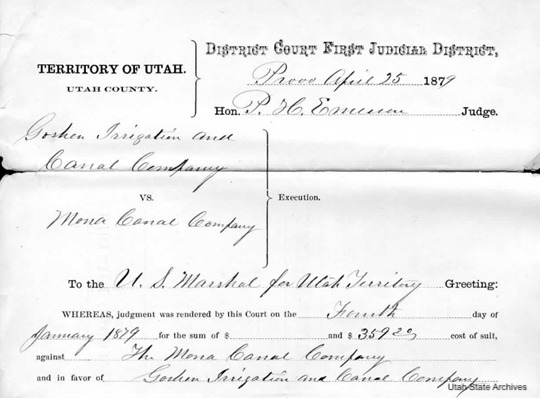Dublin Core
Title
Description
The small farming communities of Goshen and Mona sit at the base of Mount Nebo in the southern part of Utah Valley. In the late 1800s, a major conflict over water led those towns to court. At the time, most residents were members of the Church of Jesus Christ of Latter-day Saints, which was wary of secular courts meddling in local affairs. For Goshen dwellers, however, water was important enough that residents disobeyed church direction to resolve the dispute internally and took their case before a government court.
Since the early 1870s, Goshen residents had maintained and regulated a local dam. When townsfolk in nearby Mona began using water upstream from Goshen’s dam, Goshen farmers noticed immediately and feared for their livelihoods. Legal trouble soon followed. In preparation for a lawsuit, residents formed the Goshen Irrigation and Canal Company, which filed a complaint against the Mona Canal Company in 1877.
LDS Church leadership encouraged Goshen to dismiss the complaint, preferring to settle grievances through internal mediation. Avoiding the “Gentile courts” allowed church leaders to regulate water and keep the federal government from enforcing its will on Mormon communities. But, Goshen chose to refile the complaint and the lawsuit proceeded. The Goshen Company argued that members of its community had continually used the creek, regularly maintained the Goshen dam, and had prior rights to the water. The court sided with the Goshen Company, fined Mona, and forced them to relinquish their claim to the water supply.
Although Goshen won the lawsuit, church leadership still held them accountable for their rebellion. The leaders of the Goshen ward were disciplined and released from their church positions, and most ward members were disfellowshipped or excommunicated. Since they were no longer allowed to participate in church activities, a significant number of Goshen residents permanently left the faith community.
The struggle for water in Utah’s desert shows how difficult it was for the LDS Church to maintain both secular and ecclesiastical authority over their growing communities. The desire to resolve conflict without government intervention was no match for the mounting concerns over water rights.
Creator
Source
_______________
See Clinton Brimhall and Sandra Dawn Brimhall, The Goshen and Mona Water Dispute 1873-1881: A Case Study of the Struggle Between Ecclesiastical and Secular Authority in Utah, Utah Historical Quarterly vol. 78 No. 4 (2010), pg. 326-343;Pearl D. Wilson, June McNulty, and David Hampshire,“Juab County’s Mormon Settlements in the Territorial Period,” A History of Juab County, Utah Centennial County History Series, 1999 Utah State Historical Society Juab County Commission; John Bennion, Water Law on the Eve of Statehood, Utah Historical Quarterly vol. 82 no. 4 (2014), pg. 295; Farrell L. Lines, History of Goshen Valley.

